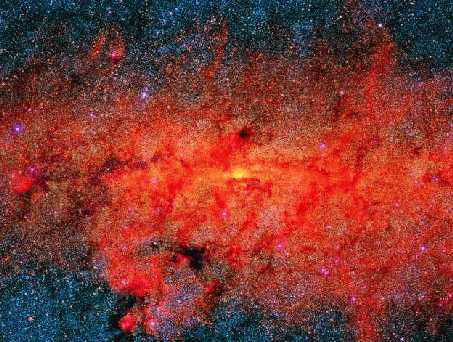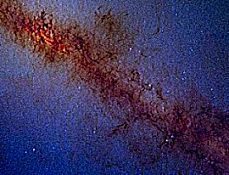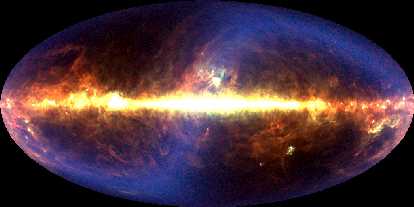



|
|

Because infrared radiation can pass more easily through gas and dust, infrared pictures reveal the structure of our galaxy much better than visible pictures can. Our galaxy, the Milky Way, radiates about half of its luminosity in the infrared.
The Milky Way is a spiral galaxy containing over 100 billion
stars. It is over 100,000 light years (or 600,000,000,000,000,000 miles) in
diameter and has a disk containing spiral arms and a dense central sphere or
bulge. The center of our galaxy is not visible at optical wavelengths
because it is hidden behind numerous clouds of gas and dust. However we can
view the center of our galaxy in the infrared, since infrared rays can
penetrate gas and dust. The image to the right is a combination of infrared
data from the 2MASS
and MSX projects.
The Galactic plane runs horizontally along the image, and the Galactic center
is the bright (yellow) object near the middle.
In the blue regions (2MASS) many stars invisible to optical
telescopes can be seen in the infrared. The red areas (MSX) show the
distribution of dust near the center of our galaxy.

2MASS Project, Umass, IPAC/Caltech, NSF, NASA

The center of our galaxy is one of the brightest
infrared sources in the sky. It is about one thousand times brighter in the infrared
than at radio wavelengths. Infrared observations show that the center of our
galaxy consists of a very dense crowding of stars and that stars and gases near
the center are orbiting very rapidly (probably due to the existence of a black
hole). The image to the left is a
near-infrared view of the center of our Milky Way Galaxy from
2MASS. This image shows
multitudes of otherwise hidden stars. The central core of our galaxy is the
brighter region at the upper, left portion of the image.
To the left is an infrared image of the entire sky from the COBE satellite. The
bright band in the middle of the image is our Milky Way galaxy.
This is how our galaxy appears from our vantage point in the sun's orbit about
the center of our galaxy. Our solar system is
located far out in the disk of our galaxy at a distance of about 30,000 light
years from the center of our galaxy
(that is about 1,760,000,000,000,000,000 miles).
It is interesting to compare
images of our galaxy at several different wavelengths .

Michael Hauser (Space Telescope Science Institute),
the COBE/DIRBE Science Team, and NASA
Infrared Universe Index |
Star Formation |
Stars |
Extrasolar Planets |
Our Galaxy |
Other Galaxies |
Between the Stars |
Missing Mass - Brown Dwarfs? |
The Early Universe
![]()